With just one humble dice you can create a whole world of learning in Kindergarten!
You don’t even have to buy a dice. A simple homemade dice made out of a building block can be used in countless activities.
I’ve been a teacher of this kind of age range for the last 12 years, and in that time I’ve come up with the ultimate selection of dice games for kindergarten. These games cover many areas of the curriculum, such as:
- Math
- Loose parts
- Team building
- And more!…
Let’s dive into the 17 ultimate dice games for kindergarten…

1. Whack the Dough
This is a brilliant counting game. All you need is some playdough and one dice. It is particularly good to play this game with children that are learning to count objects accurately with one-to-one correspondence.
Get the children to make lots of balls of dough to start with. Just a small ball, about the same size as marbles.
It’s good if you have some kind of big play-tray for this activity. Place the dough balls all over the play tray.
Then you need a dice. Any dice will do, although I do like to use the one I made myself. It looks like this:
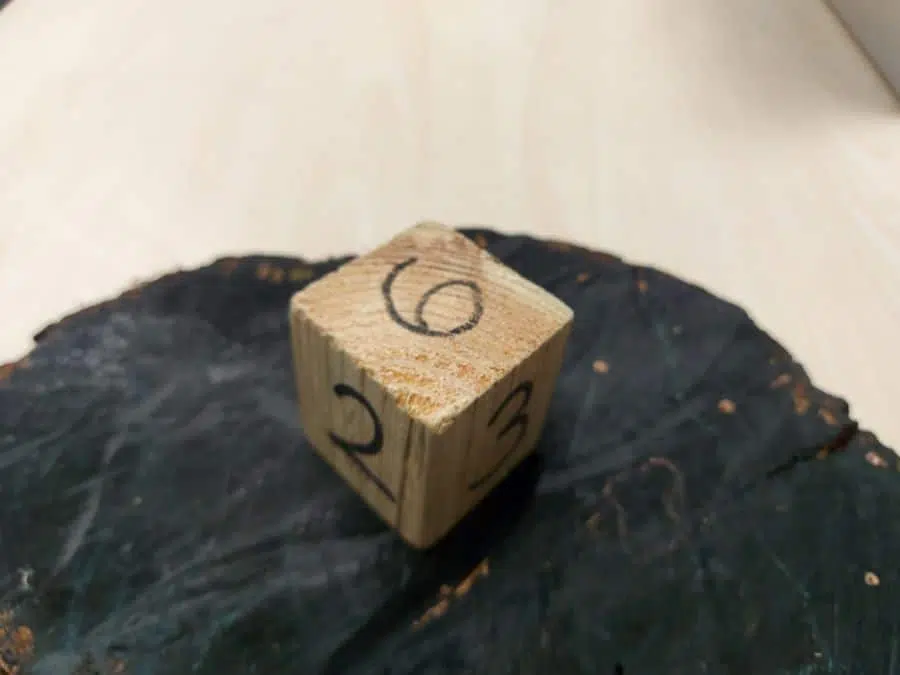
It’s basically a building block with permanent marker numbers drawn on it.
You can have anything from one to about six players at the same time involved in this.
One person rolls the dice, and then you see if everyone can recognize the number that is rolled.
Then everyone starts to whack that number of dough balls while counting at the same time!
‘1, 2, 3, 4!’ etc.
Then roll the dice, and whack that number of dough balls. This game is great for understanding that it is one action, with one number.
It is physical, fun, and visual, a perfect cocktail for early counters.
2. Whack The Dough Fly Swatters!
This is basically the same idea as whack the dough, only you use fly swatters to swat the dough!
You could also use mini mallets, and everyone wears protective goggles.
Other ways to jazz up the game include:
- Use a dice that goes up to ten or beyond
- Use two dice, calculate the total, and then whack that number
3. Pasta Race!
Here’s another nice cheap one.
All you need is a lump of dough, one piece of dried spaghetti (or a skewer), and some penne pasta (or a similar kind of tube shape).
Make a ball of playdough, and stick the piece of dried spaghetti into it, so that it is sticking up vertically.
This game is nice to play in a group of about 2 to 6 players.
Give everyone a pile of penne pasta. There is one dice.
The first player rolls the dice and sees what they get. For example, they might roll a ‘3’. That person then puts 3 pieces of pasta on the spaghetti piece.
Then the next person goes. They roll and place that quantity of pasta on the piece of spaghetti.
The winner is the person that gets to the top of the spaghetti and can put no more on! It’s a race to the top.
This is a good activity for number recognition and also for counting. It’s also good for problem-solving, and thinking – how many more pieces of pasta do we need to get to the top?
Another way to play the game is for each child to have a piece of spaghetti each. They each have their own dice, which they roll, and fill up their own piece of spaghetti. It’s a game of speed – the winner is the one that gets to the top of the piece of spaghetti first.
4. Splat The Dough Subtraction
Here’s another playdough dice game.
First, have the children create six balls of dough. Then one person rolls a dice.
Whatever is rolled, that is the number that everyone is going to whack! So, if you roll a ‘4’, then everyone whacks 4 balls of dough – 1, 2, 3, 4.
How many are left that are non-whacked?
Try writing the subtraction sentence as a group. 6 – 4 = 2. 6 is the number you start with, 4 is the number you whack, and 2 is what is left.
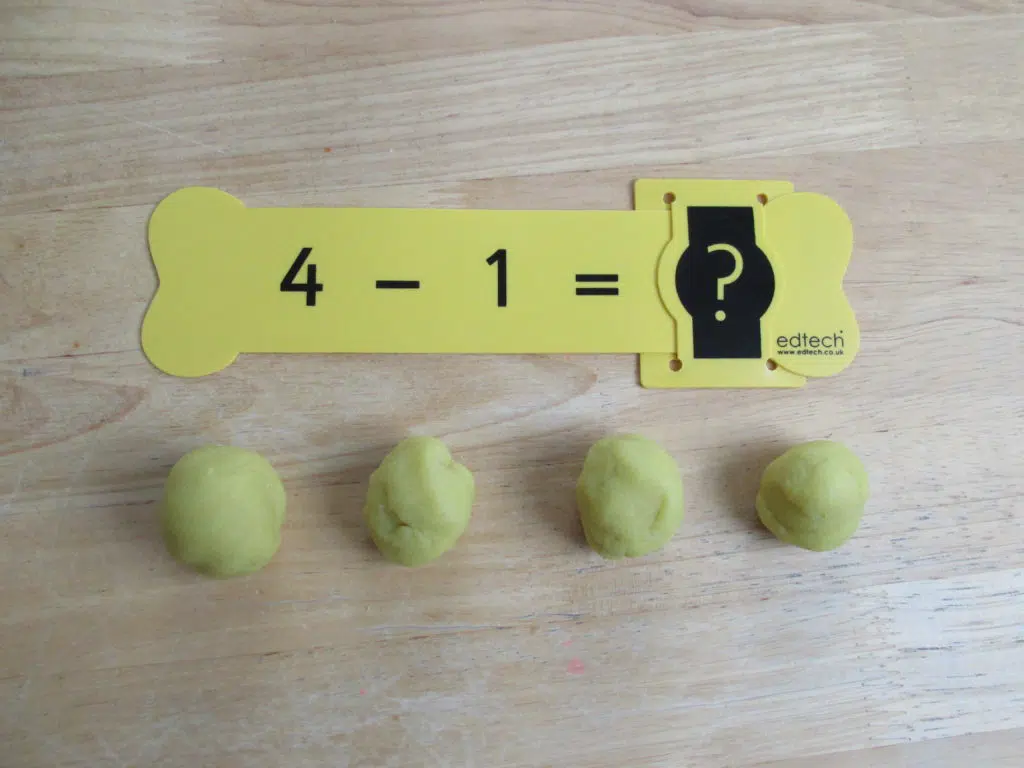
Repeat for different numbers.
You can start from anywhere between 6 to 10 balls.
5. Loose Parts – Crazy Faces
This is a great activity for combining loose parts and a dice.
You need some kind of dice (I use my homemade ones), and some tinker trays of loose parts. They will look something like this:
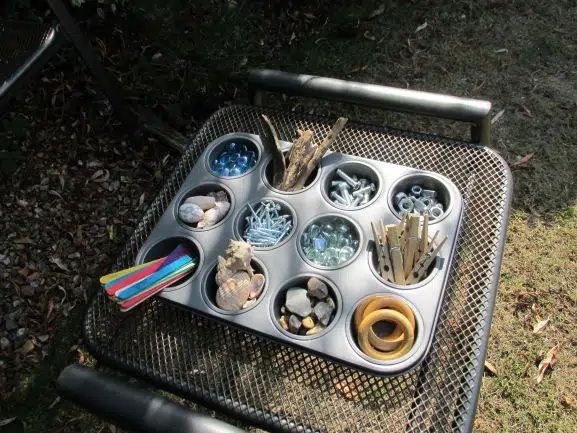
Just basically some random assorted objects in some kind of muffin tray, or similar.
It’s also good to have some kind of round natural object. You could use a cake base, for example – you know, the round and silver ones.
Alternatively, something like a placemat or a log slice would work well also. The round thing is going to be the face.
To make a ‘crazy’ face, roll a dice, and see what you get (e.g. 4). Then put that number of an object onto the face. For example, you might put four eyes (pompoms) onto the face.
Or it might be 5 strands of hair (screws).
Keep going like this, with different objects and different quantities, until you have made a crazy face. You can give your face a name or a back-story if you like.
6. Transitional Art – Stories
This is a similar activity to the last one, in that you use loose parts and a dice.
You also need some kind of board in this activity. The board is going to be the background for the story.
I like to use a wooden board that I have painted with blackboard paint (but this is not essential):
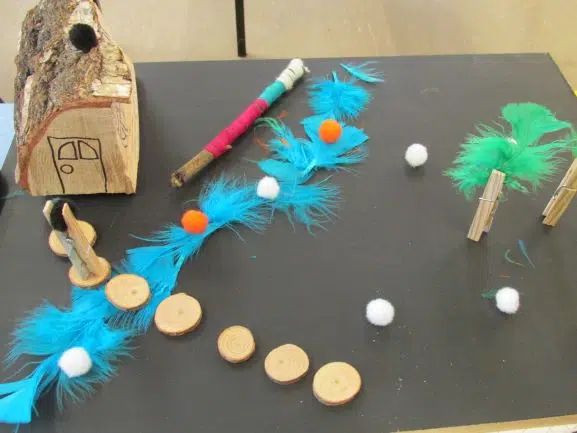
Have a tinker tray of loose parts and a dice. Roll the dice, and then put that quantity of one loose part on the board.
The idea is to make up a story. So you might roll a five and put five feathers on the board. You could say, ‘One day five beautiful birds flew over the jungle.’
Then roll again, for example getting a 3. You could put 3 stones on the board, and say, ‘They saw three big elephants stamping on a march.’
Keep going like this! It’s all about combining imagination, talking, math, and loose parts, all in one!
7. Roll Dice Squirt
Here’s a fun squirting game!
I like to use those squirty bottles that are normally used for gardening.
Have some numbers chalked on the wall. Roll a dice, and whatever number you get, try to squirt the same number on the wall.
You can adapt this game in lots of ways, such as:
- Use water pistols
- Have something like cups that you knock down when you squirt them
- Find one more or one less of a number
8. DIY Wooden Dice Games
For the next four games, you’ll need to make four very simple dice. To make the same, you just need to get four wooden building block cubes (that you don’t need anymore, because they’ll be turned into dice).
Draw on the cubes with a permanent marker.
I have created:
- A number cube
- A cube with dots on
- A cube with characters drawn on it (I’ve got a tiger, princess, robot, alien, mouse, and ghost)
- A cube with actions drawn on (I’ve got jumping, hopping, star jumps, going on your tip-toes, roaring, and going ‘sh!’)
Here’s a photo of the dice:
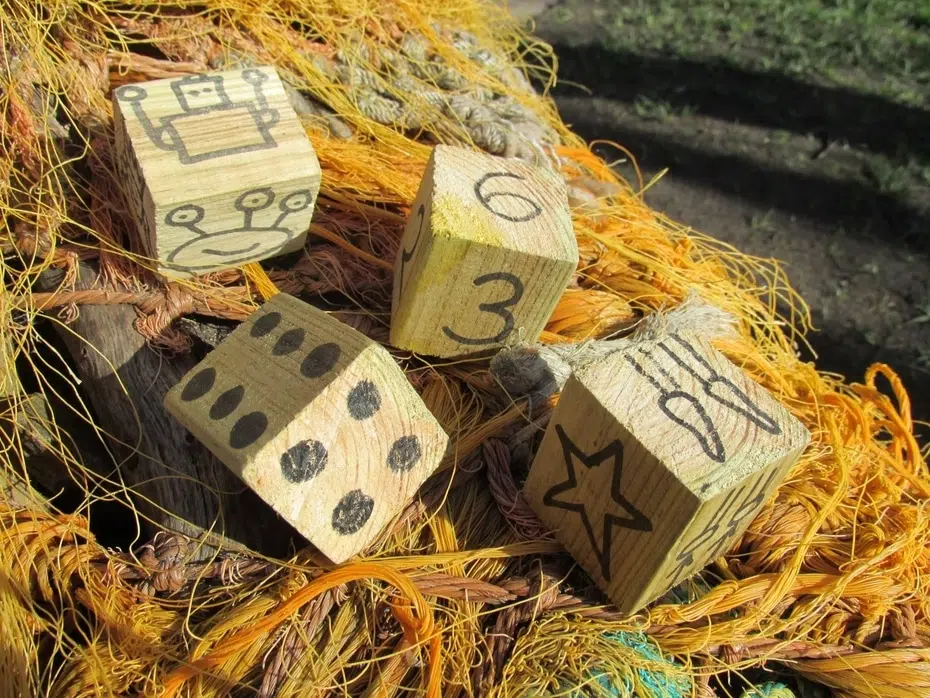
The next few games are all going to be using these four dice.
The first game is:
9. Counting In Silly Voices
This is a great rote counting game!
Quite simply, roll the character voice dice and see what you get. Then try to count in that voice.
For example, if you roll the ghost, then do your best ghost voice as you say, ‘1, 2, 3, 4…’ etc
This is great for reluctant counters and makes the task of practicing rote counting fun.
10. Character and Number Dice
This game is an extension of the one above. All you do is roll two dice this time – the character dice, and the number dice.
Say you get the alien, and the number ‘five’. This means that you start counting from ‘five’ – ‘5, 6, 7, 8, 9, 10, 11…etc’
This is quite a bit harder than counting from 1 and just gets them thinking.
11. Number Actions
I would say that this is my favorite active dice game.
You need two DIY dice for this – the actions dice, and a number dice.
Roll both – for example, you might get a ‘5’ and a ‘star jumps’. You’ve probably guessed it – you’re going to do 5 star-jumps!
Then roll both dice again, and see what other combinations you might find.
The hardest two actions are ‘roaring’ and ‘going sh!’ This is because you can’t do these noises while also counting with your mouth. You have to count on your fingers or in your head.
12. Dance Counting
All you need for this is a number dice and some kind of pumping disco tune.
Get the children to stand up. Devise some sort of simple dance routine, with about 4 different movements in sequence.
Show the children, and practice this routine.
Then roll the dice. Whatever number you get, this is the number of times that you do each movement in the routine.
So, if you roll a three, you might go, ‘three pushes up, three pushes down, three to the side, three to the other side.’
Then roll the dice, and do the same routine again, but using a different number.
13. Dice War
Let’s move more into the territory of simple dice games that can be played just with shop-bought dice and nothing else.
A great one of these games is ‘Dice War’. This is best played between 2 to 4 players. Each player needs about ten dice to start with.
They each select one dice from their pile, and everyone rolls at the same time.
Whoever gets the highest number out of the roll is the winner of that round. They get to collect all three of the dice.
Then roll again, and repeat!
If two or more dice are the highest in a single round, then that round is a draw. Just all roll again (there has to be just one highest dice for someone to win).
The way to win the game is for someone to have all the dice! This can sometimes take a long time.
14. Dice Race!
Each player needs 6 dice for this game. You can play it with 2 players, up to about 10.
One person says, ‘Go!’
The players all roll their six dice. They are going to try to get them in order from 1 to 6.
Say they roll, ‘1, 1, 1, 3, 3, 6.’
They will remove the 1, 3, and 6, and put them to one side in front of them. Then they roll the remaining three dice they have and try to get the missing 2, 4, and 5.
This is a race! Keep rolling until you have removed all six dice, and they are in order from 1 to 6.
15. One At A Time Dice Race!
This takes a little longer than the game directly above.
The idea is that each player starts with six dice. This is another game of speed.
Each player starts rolling one dice. Their aim is to get a ‘1’!
As soon as they roll a ‘1’, they put that dice to one side and start rolling the next one. They are aiming to get a ‘2’.
The aim is to get all six dice in order, from 1 to 6, first!
16. Knock Out!
This is a simple game of excitement and anticipation.
Every player needs just one dice each in this game. You can have anywhere from 2 to 6 players.
One player is designated to roll their dice to start. Whatever they roll becomes the ‘knock-out’ number.
Then, one at a time, everyone rolls their dice. If you roll the ‘knock-out’ number then you are out!
However, if you roll anything else then you are still in, and live to fight on.
The winner is the last person standing at the end.
17. DIY Tenzi
This is a game that you can buy from a shop. However, it is also possible to make your own game. All you need are sets of ten colored dice. You will need, for example, ten blue dice, ten red dice, ten green dice, etc.
Each player requires one set of ten colored dice.
You can have anywhere from 2 to about 10 players for this game (potentially more).
Everyone rolls their ten dice to start at the same time. They pick one number that has appeared a lot from that roll.
So, for example, if they roll three ‘4s’ then they will remove those 4s, and set them aside. That number is now their target number.
Then someone says, ‘Go!’
It is now a game of speed.
Everyone rolls the dice fast, each trying to roll their own target number. Whenever that number appears, they remove the dice and keep going.
The winner is the first person to have removed all ten of their dice, so they are showing the same number. At that point, they will shout ‘Tenzi!’
18. 1 to 5 Towers
This is a game of teamwork between two players. Both players need ten dice to start with.
The idea of the game is to create four towers that go up from 1 to 5.
Both players roll their ten dice to start with. They look for 1s and remove them to start building their four towers of dice. If you roll four 1s then great! You can put these as the start of the towers.
If not, just remove any you get, and then roll again.
Then when you have the four 1s pointing up, then start adding 2s to the towers. And threes etc.
At the end you will have four towers, with the numbers 1 to 5 in order pointing upwards.
19. Number Line Race
For this game, you need some kind of long line that is split into sections. This could be drawn in chalk on the floor (looking like a ladder), drawn on big paper, or drawn on something like a plank.
Here’s the one I made out of a plank painted with chalkboard paint:
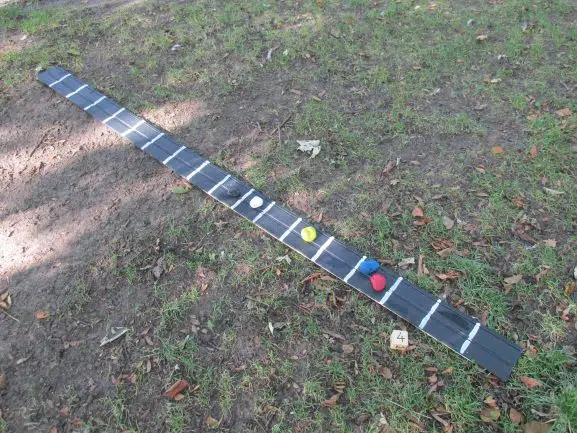
You also need one dice, and one counter per player. This is a 2-6 player game.
Everyone places their counters at one end of the number line.
Then, the first player rolls the dice. Whatever number they get, they move their counter that quantity along the number line.
Then the next person goes. And the next.
When you’ve all had one go, everyone has a second go. The winner is the first person to get to the end of the number line.
